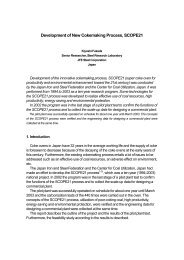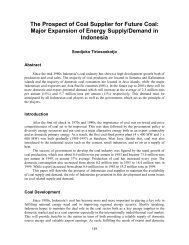Defining CCS Ready: An Approach to An International Definition
Defining CCS Ready: An Approach to An International Definition
Defining CCS Ready: An Approach to An International Definition
- No tags were found...
You also want an ePaper? Increase the reach of your titles
YUMPU automatically turns print PDFs into web optimized ePapers that Google loves.
Appendix C: Policy Considerations and Assessments of <strong>CCS</strong> <strong>Ready</strong> EconomicsAppendix C: Policy Considerations and Assessments of<strong>CCS</strong> <strong>Ready</strong> EconomicsC.1 Policy Considerations for <strong>CCS</strong> <strong>Ready</strong>By geologically s<strong>to</strong>ring CO 2 emissions from fossil-fuel based plants, global CO 2 emissions canbe reduced even with an increased consumption of fossil fuels. <strong>CCS</strong> will likely be a keycomponent of a portfolio of technologies needed <strong>to</strong> achieve significant emissions reductionsin major energy-consuming nations. Yet <strong>CCS</strong> has not been widely deployed on thecommercial scale, and there are still technical, economic, regula<strong>to</strong>ry, and policy barriers <strong>to</strong>its deployment, despite the fact that governments and industry have been working <strong>to</strong>getherfor several years <strong>to</strong> resolve these barriers.While barriers <strong>to</strong> <strong>CCS</strong> are gradually being reduced, new fossil-fuel power plants andindustrial facilities continue <strong>to</strong> be designed and built worldwide. Unless new plants aredesigned with eventual <strong>CCS</strong> in mind, higher lifecycle costs could be incurred by projectdevelopers in a carbon-constrained future. Therefore, in the interim, governments andindustry may adopt a <strong>CCS</strong> <strong>Ready</strong> policy <strong>to</strong> prepare for the future and provide potential costsavings, while <strong>CCS</strong> technology is being developed and more knowledge is gained on <strong>CCS</strong>cost and performance. <strong>CCS</strong> <strong>Ready</strong> planning and plant design, and perhaps some incrementalequipment pre-investment in order <strong>to</strong> reduce potential CO 2 lock-in, can be adoptedwithout fully committing <strong>to</strong> <strong>CCS</strong> before it has been commercially proven. If cost-effectiveprepara<strong>to</strong>ry measures <strong>to</strong> reduce GHG emissions are taken now, this may potentially lead <strong>to</strong>reduced costs and less business interruption in the future.A jurisdiction may decide <strong>to</strong> have a <strong>CCS</strong> <strong>Ready</strong> policy when it believes such a policy willfurther its existing or expected GHG goals. Even if the absence of clear GHG goals, a <strong>CCS</strong><strong>Ready</strong> policy may be adopted <strong>to</strong> help create and preserve the option for future low-cost<strong>CCS</strong> retrofits, in case a general GHG policy is later adopted. The policy decision <strong>to</strong> adopt a<strong>CCS</strong> <strong>Ready</strong> policy, and when and how <strong>to</strong> apply it, will usually be based on economic analysesindicating that the <strong>CCS</strong> <strong>Ready</strong> policy will reduce costs and/or lead <strong>to</strong> faster and more certainGHG reductions. Such a finding is usually based on the presumption that, left on its own,industry will not quickly and adequately make the proper choices in siting and designingplants <strong>to</strong> be <strong>CCS</strong> <strong>Ready</strong>, and so government intervention is justified. These policyconsiderations are discussed below in terms of key questions that can be posed.Is <strong>CCS</strong> a Viable Option for GHG Mitigation?A significant part of the decision-making process is an investigation in<strong>to</strong> the economics of<strong>CCS</strong> as a GHG mitigation measure and how it compares with other options. A <strong>CCS</strong> <strong>Ready</strong>policy is most appropriate in jurisdictions where <strong>CCS</strong> is likely <strong>to</strong> be a substantial GHGmitigation measure due <strong>to</strong> the nature of fossil fuel use, the availability of geologic s<strong>to</strong>ragecapacity, a legal and regula<strong>to</strong>ry framework conducive <strong>to</strong> <strong>CCS</strong>, and limited amounts of lessexpensive alternatives <strong>to</strong> <strong>CCS</strong>. A jurisdiction in which <strong>CCS</strong> is unlikely <strong>to</strong> ever be applied, due<strong>to</strong> technical, legal, and economic reasons, is a poor candidate for a <strong>CCS</strong> <strong>Ready</strong> policy.Will there be Policy Drivers <strong>to</strong> <strong>CCS</strong>?A <strong>CCS</strong> <strong>Ready</strong> policy would usually be based on the anticipation that <strong>CCS</strong> will beimplemented sometime in the foreseeable future due <strong>to</strong> technology mandates, emissions23 February 2010 100
















